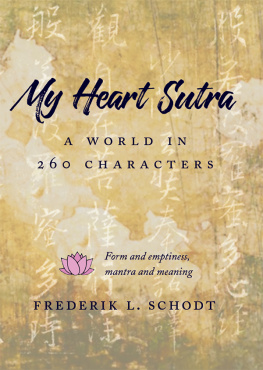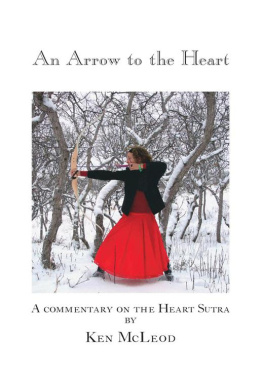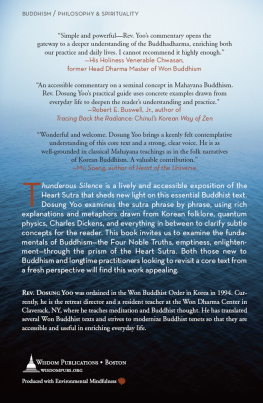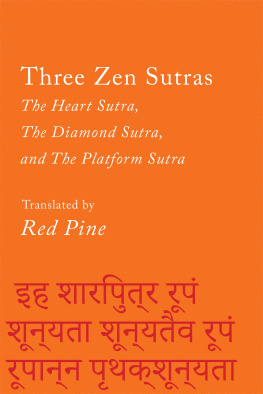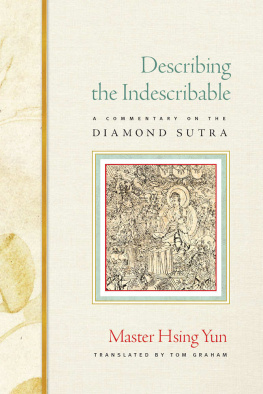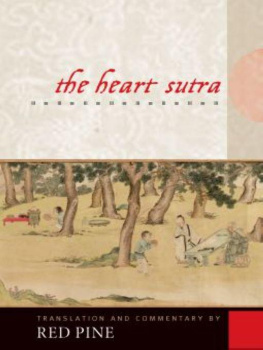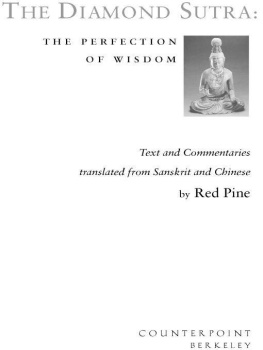to little Mason and Jacob, who kept supplying smiles and laughter, and often asked me to
do that shiki-shiki chant thing.
Foreword
This is a book of essays about the Heart Sutra, or the Heart of the Perfection of Wisdom Sutra, also known in Sanskrit as the Prajpramit Hdaya Stra . It is one of the shortest Buddhist texts and one of most popular in East Asia (and increasingly the world), chanted, copied, and contemplated by millions. It can be described in many wayspuzzling, profound, convoluted, crazy, radical, revolutionary, mysterious, magical, a gateway to Mahayana Buddhism, and an entirely new way of viewing the universe. With phrases such as form is not different from emptiness and no form, no sensation, no perception, no formation, no consciousness; no eyes, no ears, no nose, no tongue, no body, no mind , much of it at first seems a tangled mass of negatives and double negatives, all of which could be read as a long disclaimer before the great reveal of a mantra at the end.
In the same spirit, I feel obliged to give readers a few disclaimers, about what this book is, and is not.
This book is, in a sense, an inversion of the hundreds of existing books about the Heart Sutra, for I do not personally try to explain the sutras true meaning to readers. The reason? It would be presumptuous of me, because I see studying and trying to understand it as my own daily, if not lifelong task. There are many fine books in English by courageous experts who concentrate on explanations, including those by D. T. Suzuki and Edward Conze and, more recently, by Red Pine, the 14th Dalai Lama, Donald S. Lopez Jr., Thich Nhat Hanh, and Kazuaki Tanahashi, to name only a few. As the title of my book hints, this is about my Heart Sutra and my fascination with it and how it is used.
Unlike most authors on the Heart Sutra, I am not connected to a religion or a religious sect, and I am not an academic. I began this book with purely personal motives, not even sure it would yield anything worth publishing, for to me it was a challengea way to sort my own thoughts and experiences and satisfy my own curiosity. I have had an abiding obsession with the sutra and wanted to learn why, so at times it is also an archaeology of my own memory. And I wanted to look at the Heart Sutra as an unusual social and religious phenomenon. In the process, something designed to be short became longer. But like the Heart Sutra itself, it is still relatively succinct.
Unlike many writers on the Heart Sutra, who often provide their own brand-new translations, in this book I do not. Instead, I encourage readers to find translations they like among the fine ones that already exist. For reference I have included a copy of Xuanzangs Chinese version, along with a traditional St Zen English version, and a translation from the Centre of Buddhist Studies at the University of Hong Kong. Some readers may nonetheless wonder why I pay so much attention in this book to language, to the way it is used, and to translation in general. The short answer is that I have a long career in interpreting and translating and an abiding interest in cross-cultural communications, which the Heart Sutra also symbolizes.
There is little discussion in this book about Tibet or Korea or Vietnam or Mongolia or other countries where the Heart Sutra is also used. Instead, I have concentrated mainly on Greater China and Japan, or what might be called the Sino-Japanese character zone. Some readers may wonder why, and it is because an orthographically identical version of the sutra has been in use in this region for at least 1,400 years. It is the translation attributed to the Chinese monk Xuanzang, arguably the master version, and nearly all other language translations, including those in English, stem from it. Another reason is that I have some language skills that help in this area, especially Japanese. In both Korea and Vietnam, traditional ideograms have unfortunately (in my opinion) fallen out of use among the general public, often by government fiat that cuts people off from their own cultural roots. But even more to the point, I have no expertise in classical Sanskrit, Tibetan, Korean, Mongolian, or Vietnamese, and I shall not pretend otherwise.
This leaves lots of room for criticism, which is always welcome, but I hope that some readers will enjoy taking this journey with me, as I zig and zag like a butterfly through sometimes strange territories and subjects on a quirky quest, alighting here and there to listen to what others have to say, and to observe more closely. In the process, who knows? Together, we might discover something new and interesting, as well as useful, even taste some nectar!
Before jumping in, some minor housekeeping is in order. Rendering Asian names in English often makes authors want to tear their hair out in frustration (at least what little is left after writing books). The first problem with Chinese and Japanese names is their order. In this case, I have tried to maintain native Chinese/Japanese order of last name first, first name last, making an exception for people who have established themselves in the West. For example, for the calligrapher-author Kazuaki Tanahashi, who lives in Berkeley, California, and goes by Kaz, I use American name order because that is what he uses.
Romanizing Chinese names also runs into the problem of different systems used in different eras. For example, most books written about China in the twentieth century used a system called Wade-Giles. Now, most use the pinyin system. Thus, the name of the most famous Heart Sutra translator/compiler/popularizer was once usually known as Hsan-tsang. Today he is known in pinyin as Xuanzang. When quoting older English-language texts, I have kept the Wade-Giles renderings used by the original authors, but for newer texts I have used renderings in pinyin, if that is what the authors used. Turning everything into a knotted mass of complications is the fact that many Chinese people have more than one name, and many overseas or Hong Kong Chinese have used Wade-Giles or other systems of romanization for their names for generations, so it would not be proper to change them to pinyin. I hope readers will understand and show the author some mercy.

